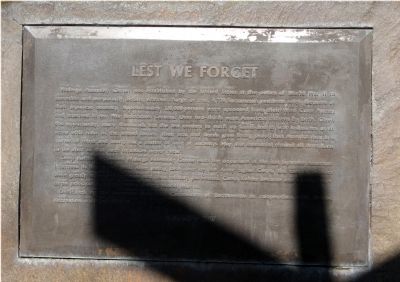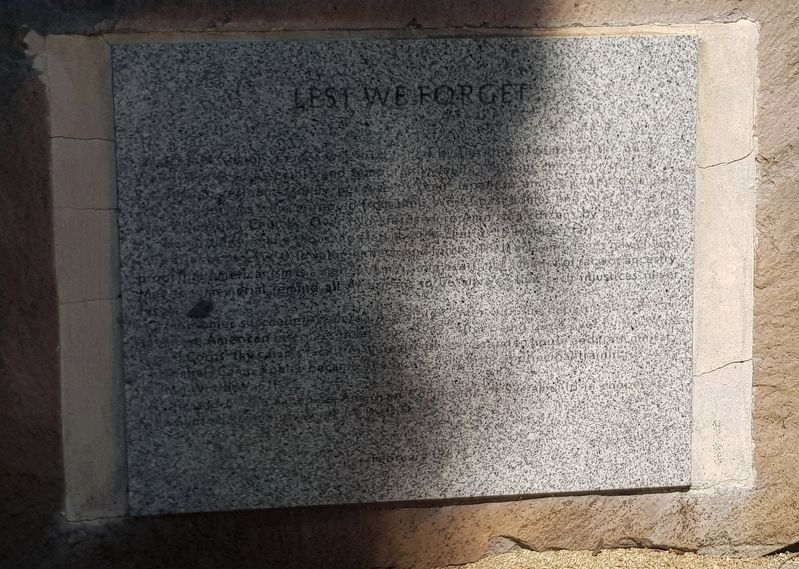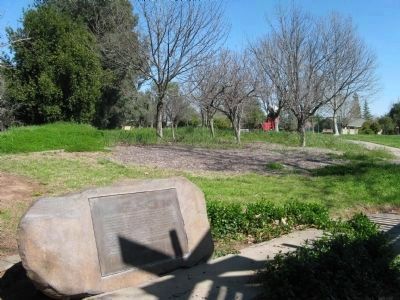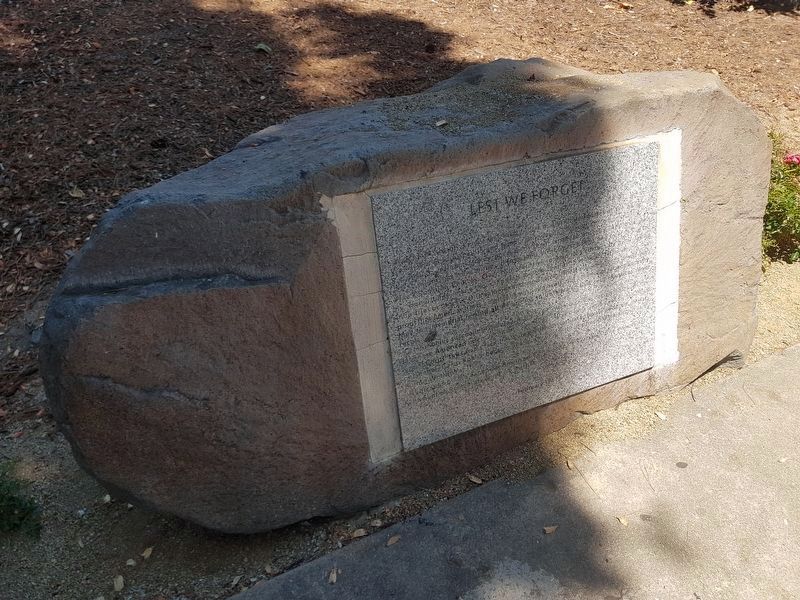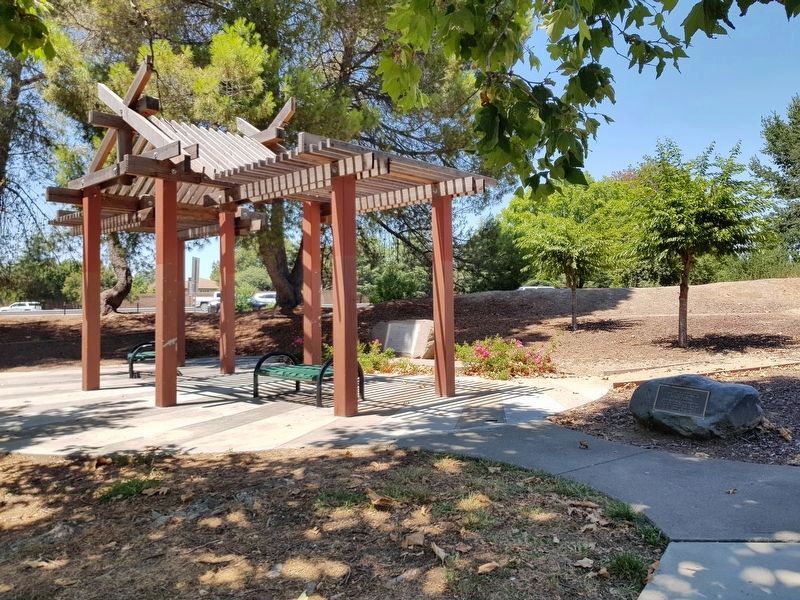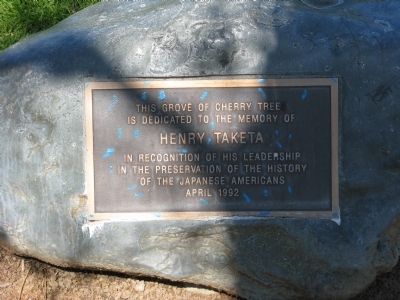Madison Woods in Sacramento in Sacramento County, California — The American West (Pacific Coastal)
Walerga Assembly Center
Lest We Forget
Camp Kohler succeeded Walerga Assembly Center with the departure of the last Japanese American internees in late June 1942. After being taken over by the Army Signal Corp, the camp’s facilities were greatly expanded to house and train military personnel. Camp Kohler became one of the Corps’ three principle training centers during World War II.
Erected 1987 by Japanese American Community of Sacramento in cooperation with Sunrise Recreation and Park District, February 1987. (Marker Number 934.)
Topics and series. This historical marker is listed in these topic lists: Asian Americans • War, World II. In addition, it is included in the California Historical Landmarks series list. A significant historical month for this entry is June 1942.
Location. 38° 40.1′ N, 121° 21.079′ W. Marker is in Sacramento, California, in Sacramento County. It is in Madison Woods. Marker can be reached from the intersection of Palm Avenue and College Oak Drive, on the right when traveling west. Marker is located at Walerga Park. The park is located at the NW corner of Palm Ave and College Oak Drive. Touch for map. Marker is in this post office area: Sacramento CA 95841, United States of America. Touch for directions.
Other nearby markers. At least 8 other markers are within 3 miles of this marker, measured as the crow flies. McClellan Air Force Base (approx. 1.9 miles away); a different marker also named McClellan Air Force Base (approx. 1.9 miles away); Base Headquarters (approx. 1.9 miles away); Bachelors' Barracks and Post Exchange (approx. 1.9 miles away); Base Hospital (approx. 1.9 miles away); Firehouse (approx. 1.9 miles away); Rapid Area Maintenance Team (approx. 2 miles away); POW/MIA (approx. 2.2 miles away). Touch for a list and map of all markers in Sacramento.
Regarding Walerga Assembly Center. This site is one of twelve Assembly Centers
designated as California Historical Landmark No. 934.
Related markers. Click here for a list of markers that are related to this marker. - Additional Temporary Detention Sites
Also see . . .
1. Camp Kohler. After the removal of Japanese detainees to permanent sites, the camp known as the Sacramento Relocation Center (Walerga) was utilized by the United States Army Signal Corps and became Camp Kohler. (Submitted on March 7, 2009, by Syd Whittle of Mesa, Arizona.)
2. Online Archive of California – Machico Date. (Submitted on March 7, 2009, by Syd Whittle of Mesa, Arizona.)
Additional commentary.
1. This site was designated as California Registered Historical Landmark No. 934 on May 13, 1980.
The temporary detention camps (also known as 'assembly centers') represent the first phase of the mass incarceration of 97,785 Californians of Japanese ancestry during World War II. Pursuant to Executive Order 9066 signed by President Franklin D. Roosevelt on February 19, 1942, thirteen makeshift detention facilities were constructed at various California racetracks, fairgrounds, and labor camps. These facilities were intended to confine Japanese Americans until more permanent concentration camps, such as those at Manzanar and Tule Lake in California, could be built in isolated
areas of the country. Beginning on March 30, 1942, all native-born Americans and long-time legal residents of Japanese ancestry living in California were ordered to surrender themselves for detention.
— Submitted March 7, 2009, by Syd Whittle of Mesa, Arizona.
2. Camp Harmony News
Camp Harmony was a "relocation center" located in Washington, and this was noted in the WASP, the camp newspaper:
Camp Harmony News-Letter
Vol. 1 No. 6 -- Puyallup, Wash. -- June 12, 1942
SAC' TO EVACUEES
LEAVE FOR TULELAKE BEGINNING JUNE 15
The Walerga WASP, Walerga Assembly center publication, revealed in its June 6th issue that 5,000 Sacramento Valley Japanese now temporarily residing in that center will be removed to the Tulelake Relocation center in northern California, beginning June 15, by order of the Western Defense Command.
The Walerga Assembly center, about 14 miles north of Sacramento, is believed to be the first temporary center whose entire population has been designated for removal to a war-duration center.
It was simultaneously revealed that residents of the Marysville Assembly center at Arboga, California, will begin moving on June 24.
An advance group of 500 Japanese from Camp Harmony and the Portland, Oregon Assembly center are already residing in the Tulelake center.
— Submitted March 7, 2009, by Syd Whittle of Mesa, Arizona.
Credits. This page was last revised on February 7, 2023. It was originally submitted on March 7, 2009, by Syd Whittle of Mesa, Arizona. This page has been viewed 4,572 times since then and 114 times this year. Last updated on January 25, 2021, by Craig Baker of Sylmar, California. Photos: 1. submitted on March 7, 2009, by Syd Whittle of Mesa, Arizona. 2. submitted on August 5, 2019, by J. Makali Bruton of Accra, Ghana. 3. submitted on March 7, 2009, by Syd Whittle of Mesa, Arizona. 4, 5. submitted on August 5, 2019, by J. Makali Bruton of Accra, Ghana. 6. submitted on March 7, 2009, by Syd Whittle of Mesa, Arizona. • J. Makali Bruton was the editor who published this page.
